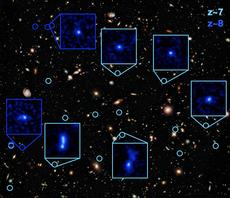Astrophysicists spot galaxies in their infancy
A new camera on the Hubble Space Telescope supplies images from depths of space never previously observed. ETH Zurich physicists are using these images to study the oldest galaxies ever discovered.

Marcella Carollo, Professor for Extragalactic Astrophysics at ETH Zurich, and her PhD student Pascal Oesch, study galaxies whose light has travelled through space for 13 billion years before being collected by the Hubble Space telescope. The universe was then only a few hundred million years old – the sources of light that Carollo and Oesch look at are primeval galaxies from which today’s galaxies originated. Pascal Oesch says: “These galaxies are about 20 times smaller than our Galaxy, the Milky Way.” Studying these galaxy seeds is important to understand the processes that built large galaxies like the Milky Way over cosmic time.
A deeper view through space and time
These early galaxies are distant and thus very faint. To detect them, the Hubble telescope was pointed at a region of the sky with very few foreground bright stars, whose light would otherwise overshine these faint sources. This patch of sky is called the Hubble Ultra Deep Field (UDF): thanks to long time exposures, the UDF data pierce particularly deeply through space and time. Marcella Carollo and Pascal Oesch are team members of the UDF09, an international collaboration coordinated by Garth Illingworth of the University of California in Santa Cruz - 09 indicates the year number of the most recent data on the UDF.
Carollo and Oesch had already found, on previous Hubble images of the UDF, four galaxies at redshift z~7, when the universe was only 600 to 800 million years old. Using a new camera, the so-called WFC3, which, at infrared wavelengths, is more than 20 times more sensitive than previous Hubble instruments, they have now been able to identify a couple dozen galaxies from such early times. Three of the newly detected faint galaxies may be as far as redshift z~10, shining their light from when the universe was only 500 million years old – this record finding has been submitted to the scientific journal Nature.
The fact that the WFC3 produces data of interest for Marcella Carollo’s research is no accident – she is one of the 15 or so members of the Scientific Oversight Committee, appointed by NASA, which supervised the development of the WFC3 in the past twelve years. In particular, Carollo’s committee prioritized for which astronomical observations the instrument was optimised. Carollo, Oesch and their collaborators were able to access the new WFC3 data ahead of the rest of the community, and thus publish their initial results as early as September 10 – only a day after NASA lifted its embargo on the new WFC3 data, and only a few weeks after the camera was installed and tested on the Hubble.
Reaching the edges of the visible universe
In a few years’ time, a new telescope should actually allow observation of the very first galaxies. The James Webb Space Telescope (JWST) will be launched into space in 2014. Like Hubble, it involves collaboration between NASA and the European Space Agency (ESA). The JWST will orbit Earth at a distance of 1.5 million kilometres, i.e., about four times further away than the Moon, much further away than Hubble (600 kilometres above the surface of the Earth). Yet, Hubble is a key pathfinder towards the JWST. Marcella Carollo explains: “The new Hubble measurements are crucial to optimise our observational strategies, and thus make the best use of JWST, which hopefully will unveil for us the first sources of light in our universe.” And ETH Zurich will again be among those in the front line: Simon Lilly, Professor for Experimental Astrophysics, is a NASA-appointed member of the Flight Science Working Group for the JWST.







READER COMMENTS